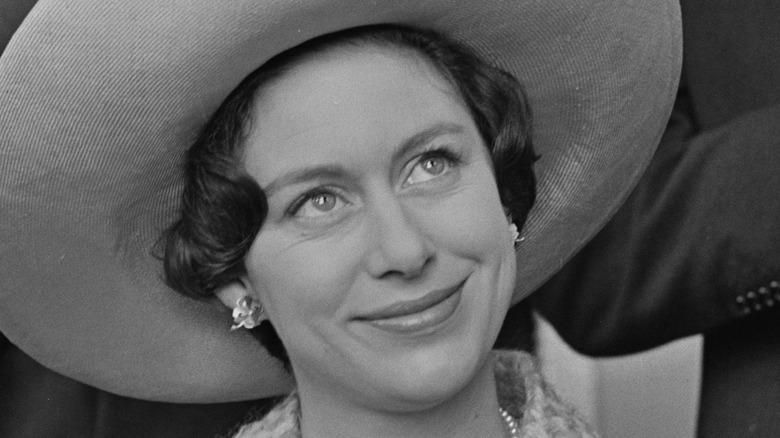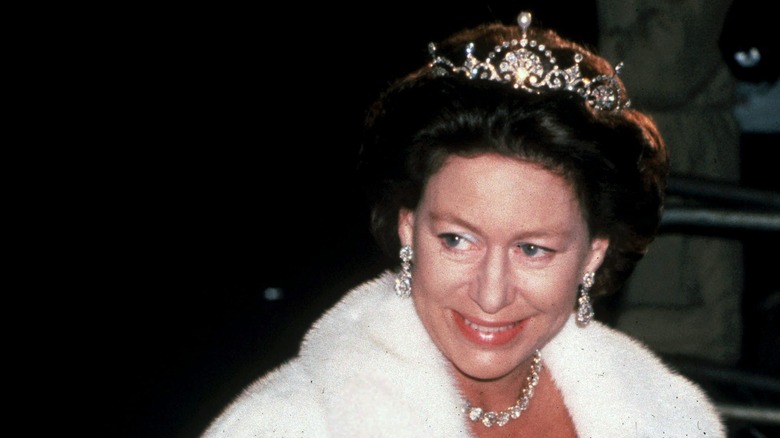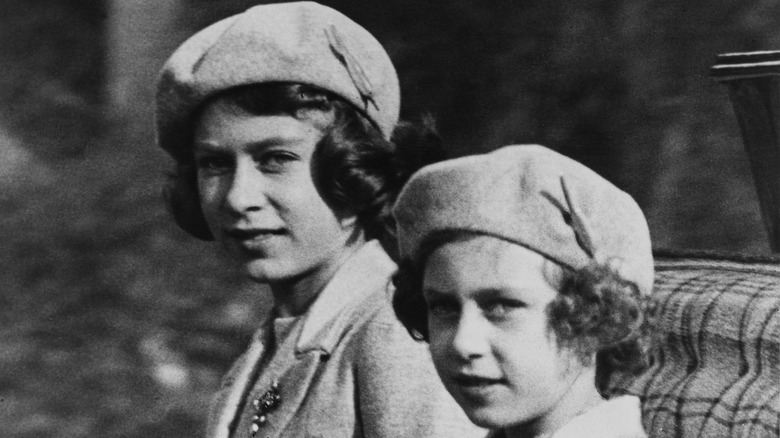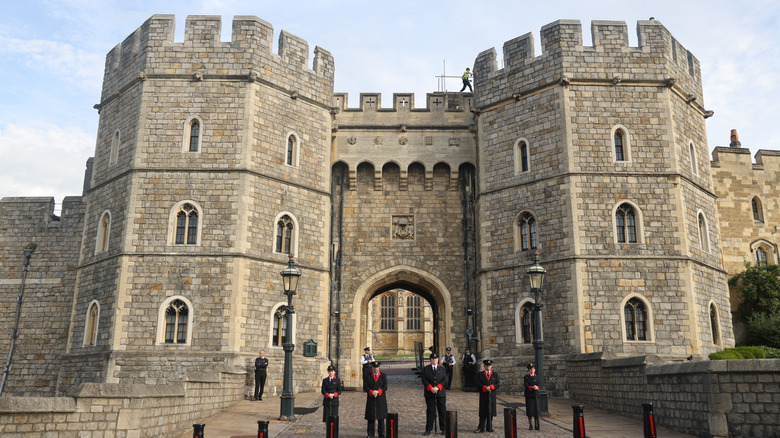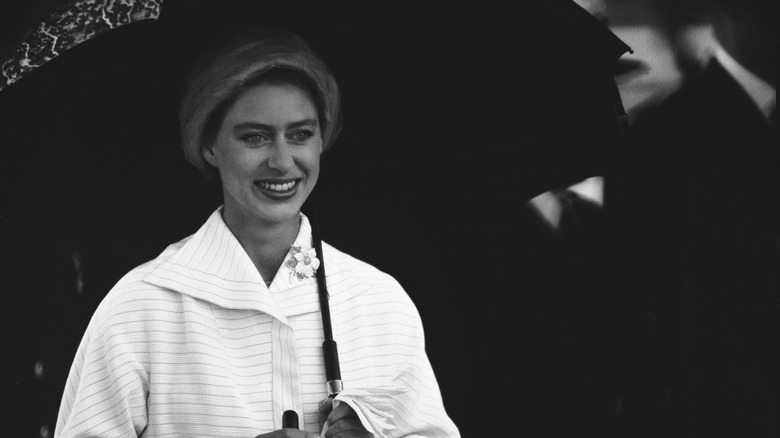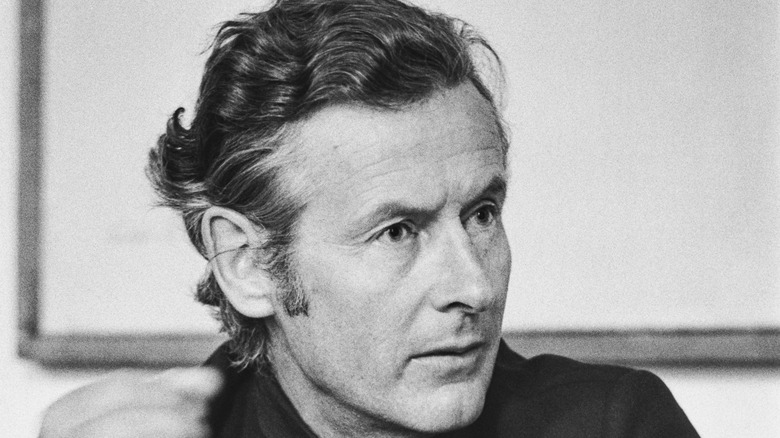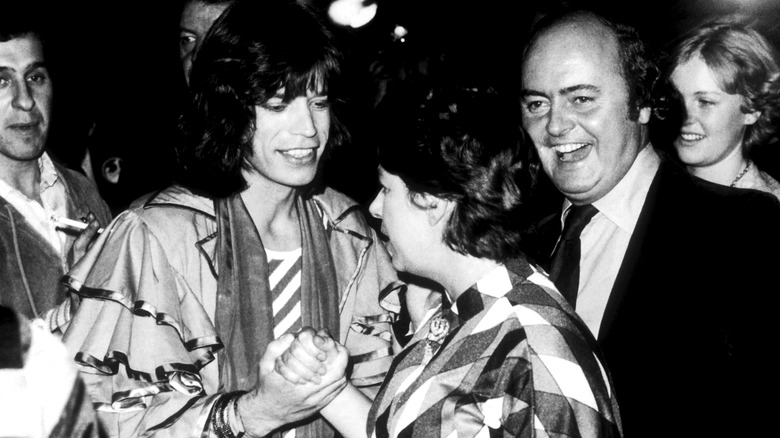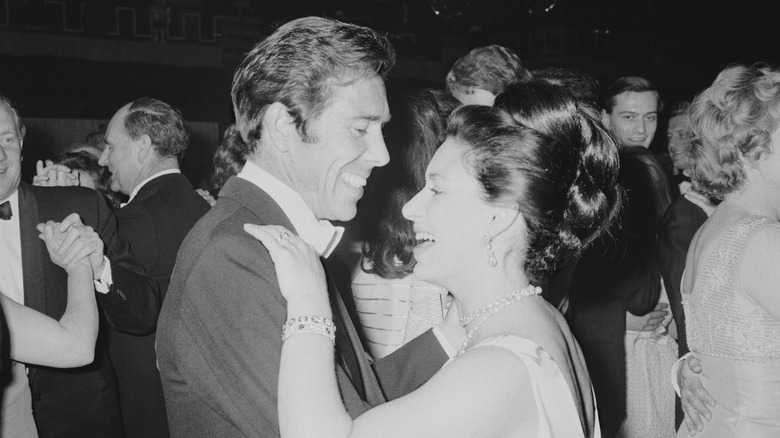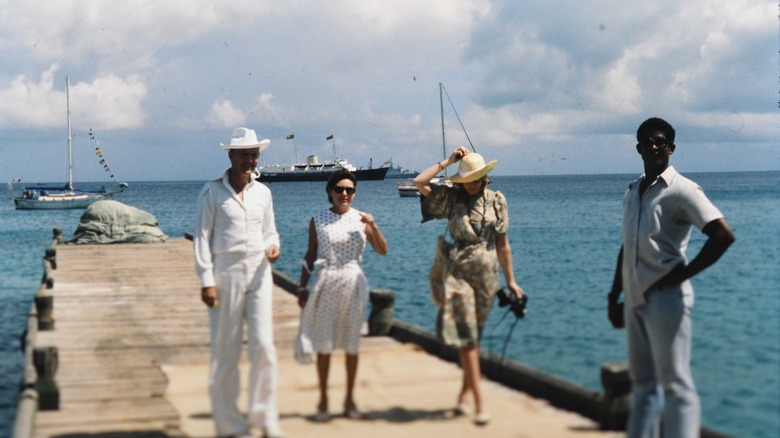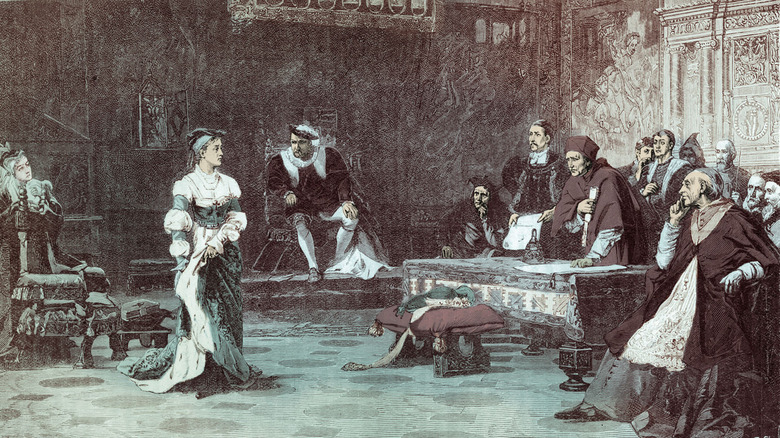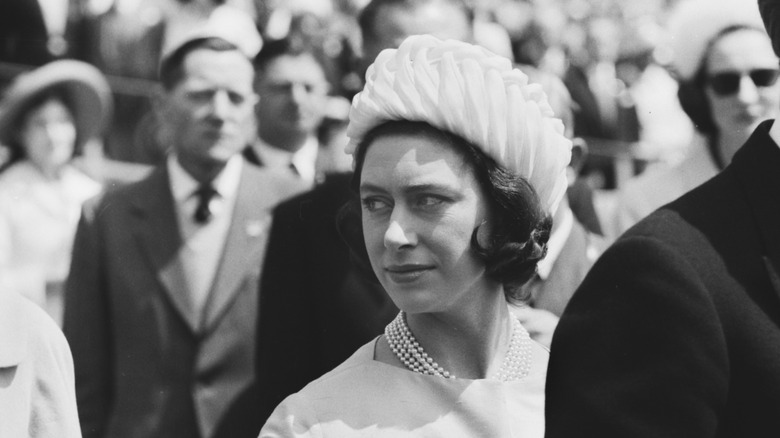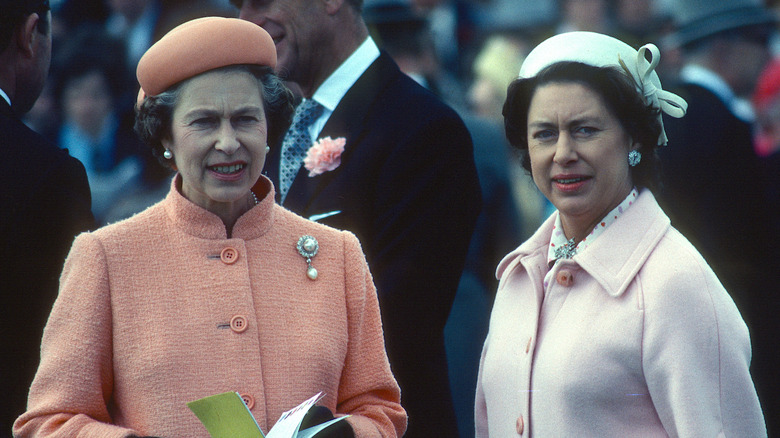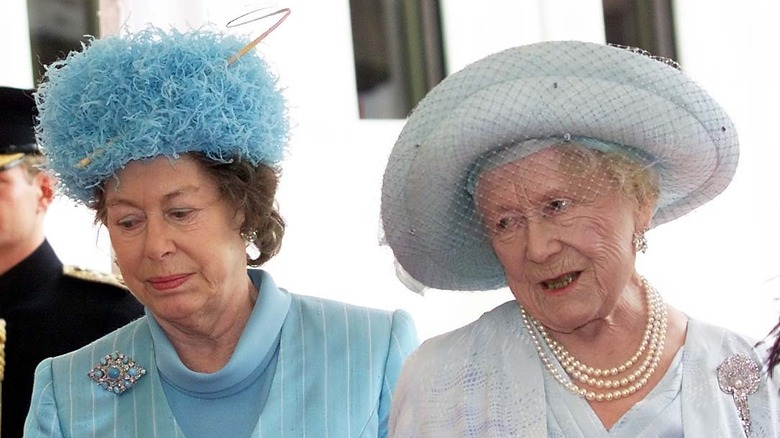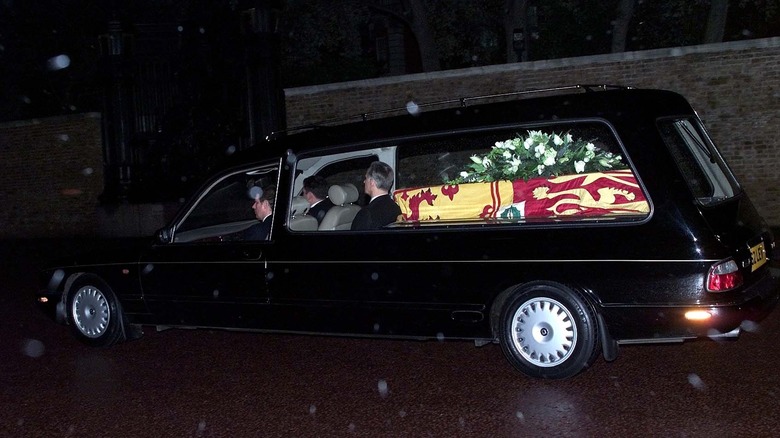The Untold Truth Of Queen Elizabeth's Sister, Princess Margaret
Many have been fascinated with the life of Princess Margaret not just because of the many historic firsts she brought to the British royal family, but also due to her wild streak that led to numerous scandalous headlines. But for all the criticism she received for her somewhat rebellious nature, the princess was also very popular for her kind heart and dedication to an assortment of charitable causes.
While it is true that Margaret never had as much responsibility as her older sister, Queen Elizabeth II, she served in her role very well, and upholding the reputation of the royal family was always of utmost importance. For that, she was not just an honored princess, but also a great sister to Elizabeth, helping to relieve some of the burdens of the crown. Princess Margaret's admirable traits like these, along with some controversial decisions, make her one of the most intriguing royals of modern times.
She was the first royal born in Scotland for 300 years
In the 17th century, King James I of England and VI of Scotland became the first monarch to rule over both countries, forming the basis of Great Britain (via Britannica). However, for the following three centuries, every single other member of the royal family was born in England, not Scotland. So, the life of the future princess Margaret was instantaneously historic as she was the first royal whose birth took place in Scotland for all those many years.
Margaret came to the world on August 21, 1930, at Glamis Castle, which was chosen as the location because it was the ancestral home of her mother, the Duchess of York (later better known as the Queen Mother). In her book, "The Wicked Wit of Princess Margaret," Karen Dolby pointed out that her Scottish origin is not the only milestone, as she was also the final member of the family whose birth had to be witnessed by the Home Secretary under law, a rather archaic practice used to prove royal status.
The future princess' birth might have been marked with one more rare characteristic as well if procedures had been followed without intervention. But according to The Independent, the registration of Margaret's birth was put on hold for days in order to prevent her from receiving the unlucky number of 13 in the parish records.
The two sisters did not receive a formal public education
The Duke and Duchess of York never enrolled either of their daughters, Elizabeth or Margaret, in public school, even after they had become princesses in 1936 when their father became King George VI. Instead, the parents hired a teacher who recently graduated from the Moray House Training College in Edinburgh named Marion Crawford — also affectionately called "Crawfie" by the future Queen Elizabeth. Crawfie was responsible for the girls' private education, but they also received valuable input from Queen Mary as well.
It is believed that at the time, the duke and duchess had no interest in their children becoming intellectuals, which is why they were educated in this way, says Christopher Warwick in his book, "Princess Margaret: A Life of Contrasts." On the other hand, there might have been some regret from the duchess on taking this approach since she got to have the experience as a child attending a Chelsea day school.
Margaret and her family took shelter in the dungeons during World War II
In 1939, King George VI and his family, including his daughter Margaret, were advised to seek refuge in Canada in order to avoid the bombings of World War II, however, they refused to abandon the country and sought the safety of Windsor Castle instead. According to the BBC, the dungeons below provided further protection when needed, not just for the royals, but also for the crown jewels, which were wrapped up in newspapers for safekeeping.
The young Princess Margaret acknowledged that the general mood was optimistic even in those tense times but was not very impressed with some of the measures taken to protect her family. Some of her comments on the bizarre environment are included in "The Wicked Wit of Princess Margaret," like when she recalled, "We were not allowed to go far from the house in case there were air raids; and there had been a pathetic attempt to defend the castle with trenches and some rather feeble barbed wire. It could not have kept anyone out, but it did keep us in."
She was the assistant director of a play called The Frog
While the young princesses Margaret and Elizabeth lived in Windsor Castle, one of the ways that the sisters passed the time was to organize the small productions of two plays, "Cinderella" and one based on the Nativity. Margaret enjoyed these childhood experiences, so when she was given the opportunity to help direct performances of Edgar Wallace's play "The Frog" in June 1954, she accepted. It was an amateur production that culminated in only three evening shows, but those involved had a lot of fun on stage regardless of the number of mistakes that were made.
The attitude of the aspiring thespians probably had much to do with their status. In his book, "Ninety-Nine Glimpses of Princess Margaret," Craig Brown described the charity event as made up predominantly of upper-class individuals, both among the cast and the audience. One notable member of this esteemed crowd was the playwright Noël Coward who was heavily critical of the performance and said, "Those highborn characters we watched mumbling and stumbling about the stage are the ones who come to our productions and criticize us! They at least displayed no signs of nervousness; they were unequivocally delighted with themselves from the first scene to the last, which, I may add, was a very long time indeed."
Peter Townsend and the princess remained friends
Princess Margaret would be part of more than one scandal throughout her life, and one of the most well-known of these began at the coronation of her sister, Queen Elizabeth, in 1953. From the way she interacted with war hero Peter Townsend at the event, it was clear there was a strong mutual attraction between the two, says The New York Times. Yet even though Townsend was a highly respected pilot in the Royal Air Force before working for the royal family, the fact that he was divorced meant that Margaret was prohibited from marrying him. When she turned 25 a few years later, the princess was free to wed Townsend without getting the queen's permission, however, Margaret would have lost her royal position and was unwilling to do so.
Townsend and Margaret may not have ended up together, but their friendship remained strong for the rest of their lives until his death in 1995 (per the BBC). Unfortunately, the two did not get to see each other often but made sure to keep in touch occasionally through letters. A few years before Townsend passed away, the two randomly ran into each other at an event, and then attended a lunch together at Kensington Palace a year later. People who saw them commented how close they still were after all those years.
Margaret might have married Canadian Prime Minister John Turner
Along with her scandalous relationship with Peter Townsend, Princess Margaret had an impressive list of individuals she is rumored to have had affairs with throughout her life, including Mick Jagger, Peter O'Toole, and Warren Beatty, says Karen Dolby in her book "The Wicked Wit of Princess Margaret." Yet, one of these speculated affairs was confirmed years later in letters written by the princess about Canadian Prime Minister John Turner.
Turner met Margaret in 1958 before he was prime minister when she was visiting Canada for the summer. The two hit it off right away, and the couple's chemistry did not go unnoticed by the local media, according to CBC News. However, their relationship was cut short, allegedly after word came from the palace to end whatever was going on.
At the time, it was unclear how serious the affair was. Years later, in 1966, the princess wrote a letter to her close friend, Sharman Douglas, and said, "John Turner is here & we meet on Thursday. It will seem so funny as we haven't met since I nearly married him & he's bringing his wife!"
The first royal wedding that was televised
Just as Princess Margaret's birth was historic, so too was her wedding to Antony Armstrong-Jones (later the Earl of Snowden) in 1960 because it was the first marriage in the royal family that was featured on television. The broadcast reached a massive audience of 300 million viewers around the world. According to "Princess Margaret: A Life of Contrasts," the bride-to-be was especially excited about the live coverage because, as she said, "Those of my friends who couldn't come could still see it. I loved that idea."
There were not nearly as many people who could view the wedding in person as on screen, but a respectable number of 2,000 guests also attended the event at Westminster Abbey. Among the esteemed attendees were Winston Churchill, the future poet laureate Sir John Betjeman, actress Margaret Leighton, and Noël Coward, along with many of her best friends.
The princess received land on Mustique Island as a wedding gift
For their honeymoon, newlyweds Princess Margaret and Antony Armstrong-Jones used the Royal Yacht Britannia to travel to the Caribbean Sea. While on their cruise, Margaret visited her friends, Colin and Anne Tennant, on the small island they owned called Mustique, located 100 miles west of Barbados. At the time, the only other inhabitants there was a tiny village of fishermen and cotton growers, yet that would soon change.
Since the couple was camping on their mostly undeveloped island, they were grateful for the offer to use the luxuries that the Royal Yacht had to offer when Margaret arrived in May 1960. According to Christopher Warwick, during this visit was when Colin asked the princess if she would prefer a wedding present in a box, or a plot of land on Mustique. Margaret saw much potential for the island, so she chose a key location on a secluded peninsula overlooking Gelliceaux Bay. Once her dream vacation home was completed, Margaret lived on Mustique as much as possible and threw many parties with major celebrities and wealthy British aristocrats in attendance (via USA Today).
The first royal marriage ended since Henry VIII
Princess Margaret continued to set records for the royal family during her life, even when it came to the end of her marriage to Antony Armstrong-Jones in May 1978, per Harper's Bazaar. The divorce of the couple was the first time that a marriage had ended (legally, at least) within the royal family since the reign of Henry VIII nearly 500 years before. However, in "Princess Margaret: A Life of Contrasts," Christopher Warwick pointed out a key difference between the two, which makes the end of the union between Margaret and her husband truly unique.
When the marriage between Katherine of Aragon and King Henry was over in 1533, it was not really through a divorce, but rather by the annulment of their union. The same process was then used to end his marriages with Anne Boleyn and Anne of Cleves as well. The distinction means that Margaret's marriage was the first one ever to have ended in the divorce court for a member of the royal family. Therefore, officially, the princess was only temporarily married, while Henry's weddings were treated as if they had never occurred at all.
The most controversial rumor is the affair she may have had with a London gangster
Of all the affairs Princess Margaret allegedly had throughout her life, there may not be a more scandalous one than with the petty gangster John Bindon. According to Karen Dolby in "The Wicked Wit of Princess Margaret," there are photos of the two at her vacation home on Mustique, but the majority of those closest to Margaret deny anything ever happened between the two. Though it is possible the princess did witness him performing his favorite lewd party trick of balancing beer glasses on his private parts.
On the other hand, there are rumors that far more risqué pictures exist, which prove that Bindon was not just a guest at Margaret's parties. Some speculate that evidence was secured in the vault of Lloyds Bank to protect the princess, and then may have been taken in the notorious bank heist of 1971 because of possible attempts from the government to censor the media, according to The Telegraph. The Express has taken this rumor to the extreme, though it is highly unlikely that the robbery had anything to do with Princess Margaret or the royal family.
There was an assassination attempt by the IRA
In October 1979, the tension between Ireland and the U.K. was extremely high after the assassination of Earl Mountbatten by the Irish Republican Army. Princess Margaret was then dangerously pulled into the conflict when a journalist claimed that she had referred to the Irish as "pigs" at an event in Chicago. According to Christopher Warwick in "Princess Margret: A Life of Contrasts," Mayor Jane Byrne was quick to deny the princess said it, and her spokesman, Lord Nigel Napier stated, "There is no truth in the allegation whatsoever" (via the Belfast Telegraph).
Despite the denials, U.S. law enforcement was alerted that a plot targeting the princess was considered by the IRA while she was in Los Angeles and her security detail quickly multiplied in response. No suspect was found after a rapid investigation, though fortunately, an attempt on her life was never made, and Margaret traveled back to the U.K. just a few days later.
Princess Margaret was the patron of 80 organizations
Most likely due to Princess Margaret's wild lifestyle at times, with famous rock stars attending her parties, the princess received some harsh criticism for not performing enough royal duties. On the other hand, she did support her sister and family through her commitment to an impressive number of 80 charities and arts organizations, according to the official Royal Household website. The princess also became president of 11 of these organizations, including the St. John Ambulance Brigade (via the BBC).
The range of organizations that Margaret supported was quite broad, but two of the main areas she focused on were the health and welfare of children, along with the treatment of those with severe illnesses. Outside of her charity work, the princess showed much support for the ballet performances she loved and became the president of the Sadler's Wells Foundation, as well as the first president of the Royal Ballet.
The princess established the first unit for ovarian cancer research in the U.K.
Supporting healthcare was clearly a very important type of charity work carried out by Princess Margaret as she was not only the president of the St. John Ambulance Brigade but also the Colonel-in-Chief of the Queen Alexandra's Royal Army Nursing Corps (via The Royal Household).
One of her most significant contributions was towards a matter much more personal, as she helped establish the first-of-its-kind ovarian cancer research unit at Belfast City Hospital in 1995, according to the BBC. As a chronic smoker, the princess had suffered through a horrific case of lung cancer, which resulted in the removal of a portion of the organ, so she was well aware of the damage the disease could do.
But Princess Margaret was far from the only one to see immense value in the cancer center. Within medical circles, Belfast gained recognition when a team located there was able to find a gene linked to ovarian cancer. The discovery secured funding from the Cancer Research Campaign and gained support from Queen's University.
She was one of the few royals who chose to be cremated
When Princess Margaret passed away in 2002, she made a decision that made her stand out in one more major way for the last time by choosing to be cremated instead of buried. Her funerary preference may have shocked her family since she is one of only a couple of senior British royals to go that route (per the New York Times), but it made perfect sense given how much she loved her father, and cremation made it possible for her ashes to be interred next to him, as explained by Christopher Warwick in "Princess Margaret: A Life of Contrasts."
But the burial beside King George VI in the Memorial Chapel was not the only reason why Margaret wanted to be cremated. The princess was often a forward-thinker throughout her life, and her view on cemeteries was no different, believing that the archaic tradition used up too much land in a world gradually running out of space.
